MPAe
Ground Based Observations of Comets
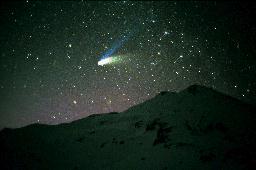
Comet Hale-Bopp above the Elbrus, which is with 5642m altitude the highest mountain of the Caucasus (Kabardino-Balkaria, Russia). (JPEG, 56 kB)

Comet Hale-Bopp above the Elbrus, which is with 5642m altitude the highest mountain of the Caucasus (Kabardino-Balkaria, Russia). (JPEG, 56 kB)
The photochemistry of the cometary comae is our main field of interest. The study of the ions, their abundance, and production rates gives indications about the nucleus constituents. Of course Comet Hale-Bopp was the primary target of the year 1997. As members of the Comet Hale-Bopp European Team we work closely together with many other scientists.
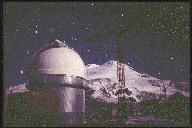 Especially for Hale-Bopp it was necessary to use a telescope in the
northern hemisphere, where observing time for a long campaign could
be gained. For near UV observations a high altitude is advantageous.
In collaboration with the Ukrainian Academy of Sciences, the newly
erected Zeiss 2m-Telscope on Pik Terskol (3100m) in the northern
Caucasus is used.
(JPEG, 69 kB)
Especially for Hale-Bopp it was necessary to use a telescope in the
northern hemisphere, where observing time for a long campaign could
be gained. For near UV observations a high altitude is advantageous.
In collaboration with the Ukrainian Academy of Sciences, the newly
erected Zeiss 2m-Telscope on Pik Terskol (3100m) in the northern
Caucasus is used.
(JPEG, 69 kB)
The instrumental contribution of the MPAe for the collaboration is the two-channel focal reducer system. It converts the f/8 telescope to a f/2.8 system with a parallel beam, where filters, fabry-perots, and a color divider are placed. Two CCD-cameras act simultaneously as detectors in different colors.
|
C/1995 O1 (Hale-Bopp) and the motion of the OH+ plasma |
|---|
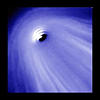 Here you can watch a movie of Hale-Bopp's OH+ ions and how these plasma structures move around the cometary nucleus (~0.5 Mb): |
| 46P/Wirtanen |
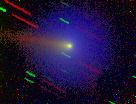 This comet has been selected as target for ESA's
Rosetta mission. To characterize the comet and set constraints
on the spacecraft and experiment design, observations were performed on
Pik Terskol. Shown is a three color image of the faint comet,
that clearly separates the three cometary components dust, neutral gas,
and ions. Click the image to get
more informations and a better
resolution!
This comet has been selected as target for ESA's
Rosetta mission. To characterize the comet and set constraints
on the spacecraft and experiment design, observations were performed on
Pik Terskol. Shown is a three color image of the faint comet,
that clearly separates the three cometary components dust, neutral gas,
and ions. Click the image to get
more informations and a better
resolution!Paper 1998A&A...335L..56J |
|
C/1995 O1 (Hale-Bopp) |
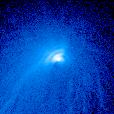 The inner dust shells and the surrounding OH+ plasma of
comet Hale-Bopp is shown in this image. It is taken in the near UV
at 360nm with the Two-Channel Focal Reducer system attached to the
Zeiss 2m-Telescope on Pik Terskol, Caucasus. Date: 15.03.1997,
2:20 UT.
The inner dust shells and the surrounding OH+ plasma of
comet Hale-Bopp is shown in this image. It is taken in the near UV
at 360nm with the Two-Channel Focal Reducer system attached to the
Zeiss 2m-Telescope on Pik Terskol, Caucasus. Date: 15.03.1997,
2:20 UT.This comet gives for the first time the opportunity to study the OH+ plasma, its motion and creation, close to the nucleus and even in front of it. Compare a continuum image of the dust with this plasma image here! |
| Additional astronomical images from Pik Terskol: |
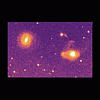 NGC 7679 & NGC 7682 |
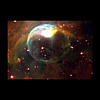 NGC 7635 |
 C/1995 O1 (Hale-Bopp) |
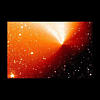 C/1995 O1 (Hale-Bopp) |
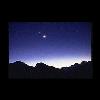 Moon and Venus above the Caucasus |
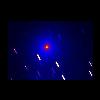 C/1996 E1 (NEAT) |
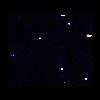 The Astra Satellites |
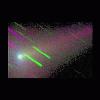 C/1996 Q1 (Tabur) |
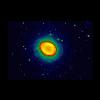 The Ring Nebula M 57 |
People involved in this work are:
Page and images by Till Credner (credner@linmpi.mpg.de), last change Mar 25th, 1999